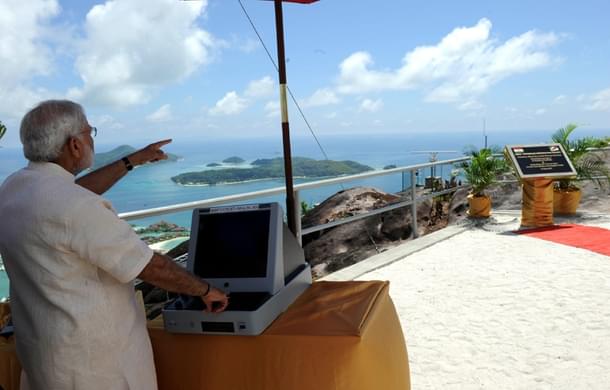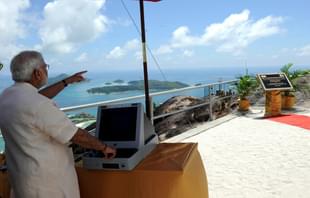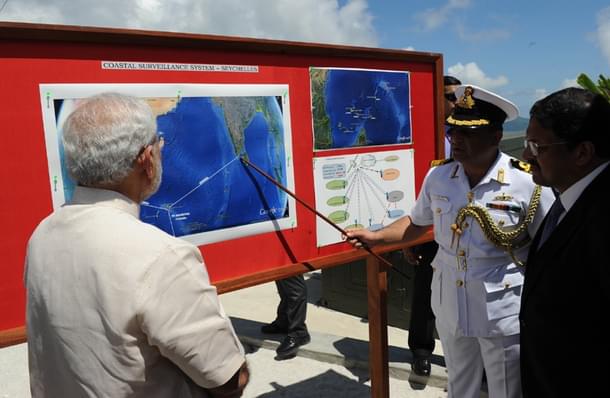World
India Asserts Its Role In The Indian Ocean
Yusuf Unjhawala
Mar 21, 2015, 01:00 PM | Updated Feb 24, 2016, 04:29 PM IST
Save & read from anywhere!
Bookmark stories for easy access on any device or the Swarajya app.


Indian Prime Minister Narendra Modi has concluded a five day tour of three Indian Ocean island nations – Mauritius, Seychelles and Sri Lanka which began on the 11th of March. The tour is widely seen as an attempt by India to reconnect with these countries after years of neglect. It was the first visit by an Indian PM to Sri Lanka in 28 years. This is a direct result of Chinese submarines docking in Colombo in September and November of 2014 which sent alarm bells ringing in the corridors of power in New Delhi and the Indian strategic community about the increasing Chinese presence in the Indian Ocean Region (IOR). The most important of the agreements signed during Modi’s visit are aimed at securing the “development rights” for two islands, Agalega in Mauritius and Assomption in Seychelles.
The Island nations of Sri Lanka, Maldives, Mauritius, Seychelles and Madagascar have always been under Indian influence. The latter three islands– Mauritius, Seychelles, and Madagascar –have substantial Indian-origin populations. Barring Madagascar, India has intervened militarily/covertly in all these countries. There exists an unwritten “Monroe Doctrine” whereby India will not entertain any government that is not pro-India or allow any “external forces” take away its influence in the region.
India’s Military Interventions
In 1983, India almost militarily intervened in Mauritius. “Operation Lal Dora” was approved by the then Prime Minister Indira Gandhi for a secret landing of Indian troops in Mauritius. These troops were to help the Mauritian Prime Minister Anerood Jugnauth fight off a challenge from his radical rival Paul Berenger which India feared might take the form of an attempted coup. The plan was aborted in favor of an operation led by India’s external intelligence Research and Analysis Wing (RAW) which was successful.
In June 1986, India under “Operation Flowers are Blooming” deployed INS Vindhyagiri at the Seychelles Port of Victoria to abort a coup attempt against President Rene. India again helped avert another coup in September of 1986 when Prime Minister Rajiv Gandhi lent President Rene his plane to fly back to Seychelles from Harare where he was attending an international meeting.
In 1988, under “Operation Cactus”, India swiftly put down a coup attempt by Tamil mercenaries in the Maldives. India landed its troops, hours after appeal from the then President of Maldives Mr. Maamoom Abdul Gayoom, which quickly secured all the vital installations in the Maldives. Swift operation by the Indian military, aided by intelligence, successfully quelled the attempted coup in the island nation.
Indian intervention in Sri Lanka is well known. Although it was to be a peacekeeping operation, it got involved in battling the LTTE and eventually withdrew. The intervention lasted from nearly three years starting July of 1987. What preceded this and the rise of the Tamil movement with Indian backing was the increasing U.S. attempts to secure a base in Sri Lanka. India was averse to any such decision during the Cold War when it was in the Soviet camp for all practical purpose though it remained non-aligned.
So India has not shied away from undertaking operations in the Indian Ocean Region whenever its interests have been threatened.
China’s Maritime Silk Route Is New String of Pearls Theory
Noted Chinese military leader Zhao Nanqi, back in the 1990s, said:“We can no longer accept the Indian Ocean as an ocean only of the Indians”. Over the last few years, as Chinese economy boomed and China’s military capabilities expanded, Beijing sought to challenge India in its backyard.
The theory of ‘String of Pearls’ came into being in which China sought to encircle India through a series of investment in ports around India’s neighbours. China has made ports in Hambantota in Southern Sri Lanka and Gwadar in Balochistan province in Pakistan. Gwadar port assumes more significance as it’s located close to the choke point of Strait of Hormuz and can monitor all shipping that goes through the region including India’s oil shipments. China is also making ports in Bangladesh and Burma.
China denied any plans to have military bases in these places but it has not convinced India’s security establishment. China has now embarked on a new project to exercise influence in the Indian Ocean Region by means of “Maritime Silk Route” which is nothing but rehashed String of Pearls. China claims it wants to revive historic trade routes and develop infrastructure that will benefit the nations along the route.
India’s Sphere of Influence
India considers its sphere of influence to extend from the Red Sea in the west to the Strait of Malacca in the east which links the Indian Ocean with the Pacific Ocean. On the western side, India has defence agreement with Oman which includes berthing right for its navy. In 2008 India signed a defence agreement with Qatar which virtually makes India the security guarantor of Qatar. India has extensive defence ties with Singapore with frequent visits by Indian Navy.
India, for most past of the last two decades, pursued a “Look East” policy to increase trade as well as influence with the countries of ASEAN and neglected the islands of the Indian Ocean Region. China stepped in providing a lot of aid and developing infrastructure. These small island countries have nothing against China and were happy to receive whatever they got from China.
India, on the other hand, has not given a lot to these countries partly because India doesn’t have the kind of money that China has. China has attempted to secure military bases in the Indian Ocean. Seychelles and Mauritius are ideal locations for China as a lot of its oil shipments from the Gulf regionand its containers containing manufactured goods destined for Europe and Americapasses the through this region. Mauritius is close to the US base of Diego Garcia. India has made sure this has not come to pass and the new deal with these two countries effectively shuts the door on Chinese attempts to secure a base.
India already has a monitoring station in northern Madagascar, complete with radars and surveillance gear to intercept maritime communication. India plans to have 32 radar stations installed across Seychelles, Mauritius, the Maldives and Sri Lanka. Prime Minister Modi handed over one such station to Seychelles during his visit. India has also provided surveillance aircraft to Seychelles and Mauritius. Modi, during his visit to Mauritius, commissioned Barracuda Naval Patrol Vessel which is the first warship to be exported by India. More is to follow.

While the countries of ASEAN already look to India to be a security provider for it in the face of increasing Chinese aggression, there has been no such indication from the island nations of the Indian Ocean. As India develops the islands it has secured from Seychelles and Mauritius, it should look to convert these into military bases and develop stronger military relation between India and both these countries. India should look to sign treaties with these countries to handle their defence just like it does for Bhutan.
In the past, on the request of Mauritius to send an officer to serve as its national security advisor, India sent General J.N. Tamini. That Mauritius has 68% of its population of Indian descent and Seychelles about 10% will help India pursue the goal of taking over the defence responsibilities of these two countries. The affinity they have towards India was visible with the kind of reception Modi got from them. India can leverage this to create a military alliance.
India’s Need for Overseas Bases
The fear of China from East China Sea to Eastern Africa is genuine and present. China helped rig the elections in Zimbabwe to get the autocratic Robert Mugabe re-elected in 2013. Mugabe has been ruling the country as President since 1987. In Sri Lanka, it backed former President Mahinda Rajapakse. It has got several infrastructure projects at inflated price with a not a lot to gain for the local population and wholeheartedly helped with his campaign to get re-elected. From East Asia to Eastern Africa, the threat of China is there and India, with its growing economic and military power, is looked upon as a source for security and stability.
India should look at having military bases in foreign countries, something it has been shy of. After Singapore became an independent republic in 1965, it asked India to guarantee its security and asked for Indian naval assets to be stationed there. The then Prime Minister of India, Indira Gandhi refused to take any security role in the region. In the 1980s, Zimbabwe had asked the then PM Rajiv Gandhi to station Mig 21s in Zimbabwe and Mozambique. Rajiv Gandhi declined saying he is was not in favor of deploying bases on foreign shores. A look at the US and the way its military operates shows us that strong friends, alliances and bases all over the world is what helps it project power. Having bases in various countries will effectively deter China from meddling the affairs of the host country that may be against the interest of India.
Conclusion
While India develops its naval assets of aircraft carriers, submarines and other surface combatants to project power across the region, it will have to develop a strategic doctrine for the Indian Ocean Region all the way to East China Sea. Having a strong navy is only the means to achieve the strategic objectives. Otherwise it will be like soldiers sent on a mission without any specified objectives.
Indian Ocean is India’s backyard and the security of India depends on the security of the Indian Ocean and the countries that are littoral of it. India has to look to create strong military alliances with these countries to make the ocean truly India’s. We have made a new start with PM Modi’s visits to the Indian Ocean Islands.
Yusuf Unjhawala is Editor, Indian Defence Analysis, an online forum on defence and strategic affairs of India. He comments extensively on defence and geopolitics.





